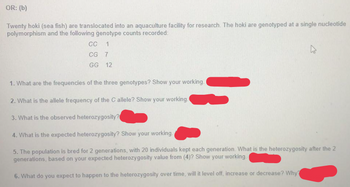
Human Anatomy & Physiology (11th Edition)
11th Edition
ISBN: 9780134580999
Author: Elaine N. Marieb, Katja N. Hoehn
Publisher: PEARSON
expand_more
expand_more
format_list_bulleted
Concept explainers
Question
please answer 1 , 2 , 3
asap

Transcribed Image Text:OR: (b)
Twenty hoki (sea fish) are translocated into an aquaculture facility for research. The hoki are genotyped at a single nucleotide
polymorphism and the following genotype counts recorded:
CC 1
CG 7
GG 12
1. What are the frequencies of the three genotypes? Show your working.
2. What is the allele frequency of the C allele? Show your working.
3. What is the observed heterozygosity?
4. What is the expected heterozygosity? Show your working.
5. The population is bred for 2 generations, with 20 individuals kept each generation. What is the heterozygosity after the 2
generations, based on your expected heterozygosity value from (4)? Show your working.
6. What do you expect to happen to the heterozygosity over time, will it level off, increase or decrease? Why?
Expert Solution
This question has been solved!
Explore an expertly crafted, step-by-step solution for a thorough understanding of key concepts.
Step by stepSolved in 2 steps

Knowledge Booster
Learn more about
Need a deep-dive on the concept behind this application? Look no further. Learn more about this topic, biology and related others by exploring similar questions and additional content below.Similar questions
- I need help with thesearrow_forwardhttps://wowzahttp.cengage.com/geyser/corey_9780357764428/video/video.html?asset=5_personcentered After watching the video, please respond in writing to both of the following questions: 1). What feelings did you experience about the counseling session portrayed in this video? 2). Did your feelings change after viewing Dr. Corey’s reflections on the counseling session? If so, please explain how your feelings changed.arrow_forwardAnswer- 0arrow_forward
- Post a short summary about the assigned video posted below https://www.youtube.com/watch?v=5-bN7qB_kckarrow_forward3r0 degree Question 66 U UUU UUC UUA UUG CUU CUC CUA CUG Phe AUU Lou GUU GUC GUA GUG HELP CENTER Leu Arg C UCU- UCC UCA UCG- ACU- AUC ACC AUA ACA Met or AUG Start ACG SECOND BASE CCU CCC CCA CCO -Val acu- acc Ser GCA aca Question 67 G UGU-1 UGC UAA Stop UGA Stop A UAG SUGG Trp G UAU UAC Pro Thr A CAU CAC CAA CAG Ala -Tyr -His AAU- AAC- AAA- AAG GAU GAC GAA GAG -Gin Asn -Lve Lys CGU CGC CGA coa -Asp -Glu AGU AGC AGA AGG -Cys GOU GGC GGA GGG U Arg U Ic -Ser Arg Gly A U С 4 Use the chart to find the amino acid that the DNA triplet AGG codes for. Write the 3 letter abbreviation for the correct amino acid. Full thickness burn tharrow_forwardFor each genotype below, indicate whether it is heterozygous or homozygous. Write PAUL if its heterozygous and STEM if its homozygous.arrow_forward
arrow_back_ios
SEE MORE QUESTIONS
arrow_forward_ios
Recommended textbooks for you
 Human Anatomy & Physiology (11th Edition)BiologyISBN:9780134580999Author:Elaine N. Marieb, Katja N. HoehnPublisher:PEARSON
Human Anatomy & Physiology (11th Edition)BiologyISBN:9780134580999Author:Elaine N. Marieb, Katja N. HoehnPublisher:PEARSON Biology 2eBiologyISBN:9781947172517Author:Matthew Douglas, Jung Choi, Mary Ann ClarkPublisher:OpenStax
Biology 2eBiologyISBN:9781947172517Author:Matthew Douglas, Jung Choi, Mary Ann ClarkPublisher:OpenStax Anatomy & PhysiologyBiologyISBN:9781259398629Author:McKinley, Michael P., O'loughlin, Valerie Dean, Bidle, Theresa StouterPublisher:Mcgraw Hill Education,
Anatomy & PhysiologyBiologyISBN:9781259398629Author:McKinley, Michael P., O'loughlin, Valerie Dean, Bidle, Theresa StouterPublisher:Mcgraw Hill Education, Molecular Biology of the Cell (Sixth Edition)BiologyISBN:9780815344322Author:Bruce Alberts, Alexander D. Johnson, Julian Lewis, David Morgan, Martin Raff, Keith Roberts, Peter WalterPublisher:W. W. Norton & Company
Molecular Biology of the Cell (Sixth Edition)BiologyISBN:9780815344322Author:Bruce Alberts, Alexander D. Johnson, Julian Lewis, David Morgan, Martin Raff, Keith Roberts, Peter WalterPublisher:W. W. Norton & Company Laboratory Manual For Human Anatomy & PhysiologyBiologyISBN:9781260159363Author:Martin, Terry R., Prentice-craver, CynthiaPublisher:McGraw-Hill Publishing Co.
Laboratory Manual For Human Anatomy & PhysiologyBiologyISBN:9781260159363Author:Martin, Terry R., Prentice-craver, CynthiaPublisher:McGraw-Hill Publishing Co. Inquiry Into Life (16th Edition)BiologyISBN:9781260231700Author:Sylvia S. Mader, Michael WindelspechtPublisher:McGraw Hill Education
Inquiry Into Life (16th Edition)BiologyISBN:9781260231700Author:Sylvia S. Mader, Michael WindelspechtPublisher:McGraw Hill Education

Human Anatomy & Physiology (11th Edition)
Biology
ISBN:9780134580999
Author:Elaine N. Marieb, Katja N. Hoehn
Publisher:PEARSON

Biology 2e
Biology
ISBN:9781947172517
Author:Matthew Douglas, Jung Choi, Mary Ann Clark
Publisher:OpenStax

Anatomy & Physiology
Biology
ISBN:9781259398629
Author:McKinley, Michael P., O'loughlin, Valerie Dean, Bidle, Theresa Stouter
Publisher:Mcgraw Hill Education,

Molecular Biology of the Cell (Sixth Edition)
Biology
ISBN:9780815344322
Author:Bruce Alberts, Alexander D. Johnson, Julian Lewis, David Morgan, Martin Raff, Keith Roberts, Peter Walter
Publisher:W. W. Norton & Company

Laboratory Manual For Human Anatomy & Physiology
Biology
ISBN:9781260159363
Author:Martin, Terry R., Prentice-craver, Cynthia
Publisher:McGraw-Hill Publishing Co.

Inquiry Into Life (16th Edition)
Biology
ISBN:9781260231700
Author:Sylvia S. Mader, Michael Windelspecht
Publisher:McGraw Hill Education